Sustainability - Climate Change
Since its establishment in 1897, Meidensha has produced a range of technologies, products, and services and contributed to the development of a sustainable society in its role as a manufacturing company. In particular, we are deeply involved with decarbonization and reduction of carbon through power generation systems that utilize renewable energy sources such as solar, wind, and small to medium hydroelectric, as well as energy solution services such as smart grids. Through these eco-friendly products and services, we aim to achieve a sustainable society and are working to reduce greenhouse gas emissions from business activities.
As the highest decision-making body with regard to environmental activities, the Meiden Group Environmental Committee, which is chaired by the Executive Officer (Environment), identifies issues including risks posed by climate change and deliberates concerning environmental targets, action plans, and emergency response, etc., as well as determining environmental management direction. As part of its role, the Environmental Committee refers important matters to the Executive Officers’ Meeting and the Board of Directors, etc., to initiate activities based on executive-level decision-making.
To enhance our activities for mitigating environmental impact, we use internal carbon pricing and source CO2-free electricity (in FY2023, sites that sourced CO2-free electricity were Numazu Works, Head Office’s ThinkPark Tower, and others). As a result, Scope 2 emissions fell even as production increased. However, Scope 1 rose due to growing SF₆ gas emissions resulting from greater production of power equipment products and because of increased use of drying furnaces. We will continue working to control Scope 1 and 2 emissions, for example by eliminating SF6 gas and electrifying our drying furnaces.

Scope 1: Direct Emissions
Combustion of fuel (town gas and oil, etc.) and release of greenhouse gasses (SF6and CFCs, etc.)
Scope 2: Indirect Emissions
Combustion of fossil fuel to generate electricity (electricity company) that is consumed by the company
The Meiden Group had record sales in FY2023 and lowered its CO2 emissions per unit of sales.
We also drove down CO2 emissions by starting to use renewable energy at Numazu Works, the Group’s largest production site in Japan.
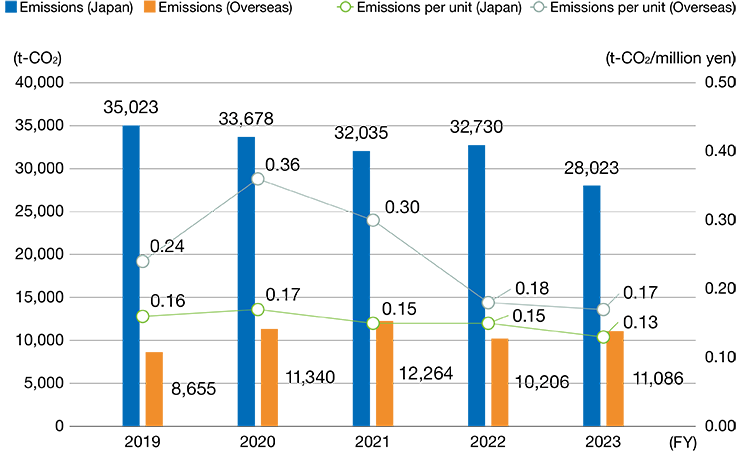
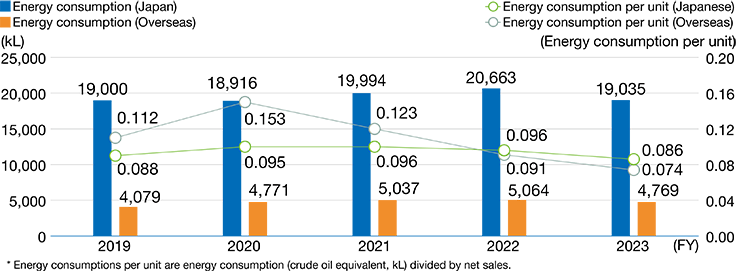
In recent years, we have procured electricity from renewable sources in an effort to reduce CO2 emissions from business activities.
Since FY2019, we have been working on sourcing electricity with non-fossil certificates and purchasing power from renewable sources.
In FY2024, we signed an offsite physical corporate PPA* on April 1. This arrangement uses electric power from renewable energy of Choshi Shiosai Wind Farm owned and operated by M WINDS Co., Ltd., a Meiden Group company.
| FY2019 |
November: Began sourcing CO2-free electricity from wind power through non-fossil certificates with tracking information at the Meiden R&D Center and Osaki Kaikan Hall. |
|---|---|
| FY2020 |
November: Signed power contract (special contract for renewable energy) at EAML Engineering CO., LTD. and began sourcing CO2-free electricity, mainly from hydroelectric power. |
| FY2021 |
April: Signed power contract (Gunma Hydroelectric Power Source Plan) at Ota Works and began sourcing CO2-free electricity from hydroelectric power. January: Signed power contract (Carbon F Plan) at Chiba R&D location of MEIDEN NANOPROCESS INNOVATIONS, INC. and began sourcing CO2-free electricity from hydroelectric power. |
| FY2022 |
May: Signed power contract (Green Basic Plan) at KOFU MEIDENSHA ELECTRIC MFG. CO., LTD. and began sourcing 30% of the power it uses in the form of CO2-free electricity from solar and wind power. May: Began sourcing CO2-free wind power at headquarters of MEIDEN KOHSAN CO., LTD. using non-fossil certificates with tracking information. |
| FY2023 |
July: Signed power contract at Meidensha’s Numazu Works (Green Basic Plan) and began sourcing 20% of the power it uses in the form of CO2-free electricity from solar and wind power. July: Signed power contract (Green Basic Plan) at Meidensha’s Headquarters (ThinkPark Tower) and began sourcing CO2-free electricity from solar and wind power, etc. |
| FY2024 |
April: • Signed contract to source CO2-free electricity for 100% of the power used at three Group sites in the Tokyo area (R&D Center, Osaki Kaikan Hall, and MEIDEN KOHSAN CO., LTD.) (86% under Green Basic Plan contract, 14% under offsite physical corporate PPA). • Meidensha’s Numazu Works gets 34% of its power from CO2-free electricity, while KOFU MEIDENSHA ELECTRIC MFG. CO., LTD. gets 44% (in addition to previous sources, it procures 14% under an offsite physical corporate PPA) • Meidensha’s Ota Works switched from the Gunma Hydro Plan to the Green Basic Plan and now sources CO2-free electricity derived from solar, wind, and other forms of energy for 100% of its power |
Internal carbon pricing is a mechanism to promote investment in equipment with a significant CO2 reduction benefit. It works by setting a carbon price within a company and using it to calculate the cost of greenhouse gas emissions.
Meidensha introduced the internal carbon pricing system in April 2021. We will convert carbon emissions from capital investment plans to expenses using an internal carbon price through the system. It will be a tool to make investment decisions. At Meidensha, we initially set ¥3,000/t-CO₂ as the internal carbon price. However, after considering the Ministry of the Environment guidelines and the carbon price under the IEA’s 1.5°C scenario, we raised our internal price to ¥15,000/t-CO₂, which applies to capital investment starting in FY2023. We will continue to promote reductions in greenhouse gas emissions in our business activities by considering environmental impact mitigation along with safety and productivity when making equipment investment decisions.
There were 10 cases in FY2023 in which we applied internal carbon pricing. For example, we introduced equipment that is expected to significantly lower CO2 emissions, such as replacing lighting in the elevator halls at Head Office with LED bulbs and replacing testing equipment, compressors, and air-conditioning equipment at production plants.
| Equipment subject to internal carbon pricing (FY2023) | 277 (million yen) |
|---|---|
| Reduction due to internal carbon pricing* | 987(t-CO2) |
On April 1, 2024, Meidensha, M WINDS Co., Ltd., and TEPCO Energy Partner, Incorporated (“TEPCO EP”) entered into an offsite physical corporate PPA (“the PPA”). This arrangement uses electric power from renewable energy (“the renewable power”*1) from Choshi Shiosai Wind Farm (“the power plant”) owned and operated by M WINDS, a wholly owned subsidiary of Meidensha.
Under the PPA, a portion of the electricity used at five Meiden Group business sites is now renewable power from the power plant.
More than 20 years have passed since the plant started operating in December 2003, and the FIT period (October 2012 - March 2024) has now elapsed. The three companies concluded the PPA to maximize the value of the wind power plant owned by the Meiden Group and enhance corporate value.
For the three businesses, this is a first-time experiment with a PPA using a wind farm that has moved past the FIT program.

1. Overview of the PPA
Concerning the renewable power generated with the plant, the previous arrangement used FIT non-fossil certificates*2 with tracking information by TEPCO EP to provide only environmental value to three Tokyo area sites of the Meiden Group (R&D Center, Osaki Kaikan Hall, and Meiko Bldg.) using the Green Basic Plan.*3
Now that the PPA has been concluded, both the power generated at the plant and the environmental value will be provided, in addition to the Green Basic Plan that TEPCO EP was already offering. With the addition of Meidensha’s Numazu Works and KOFU MEIDENSHA ELECTRIC MFG. CO., LTD. (“KOFU MEIDENSHA”), a total of five locations will be supplied. Another advantage is that the Meiden Group can use the PPA to stabilize the cost of sourcing some of its electricity, regardless of changes in fuel prices.

Meidensha Corporation took the Excellence Prize at Zero Carbon Challenge Cup 2023, sponsored by the Japan Network for Climate Change Actions.
The Zero Carbon Challenge Cup is a Japan-wide competition that honors outstanding local decarbonization efforts by schools, organizations, companies, local governments, and others seeking to prevent global warming. Judges review documentation and presentations from entrants to decide the winners. The purpose is to share expertise and information on excellent initiatives across the country, creating momentum for further activities and collaborations through a program of awards for decarbonization initiatives by various entities across Japan.
In this running of the event, after the document review, 29 of the 199 organizations that applied were chosen to give presentations.
Meidensha gave a presentation titled “Contributing to Carbon Neutrality throughout the Entire Meiden Group’s Value Chain.” It described our project to rebuild the Meiko Bldg., where Group companies MEIDEN KOHSAN CO., LTD. and MEIDEN ENGINEERING CORPORATION have their head offices. The project was carried out according to the concept of creating a cutting-edge office that can contribute to environmental protection, work-style reform, disaster prevention, and coexistence with the local community.
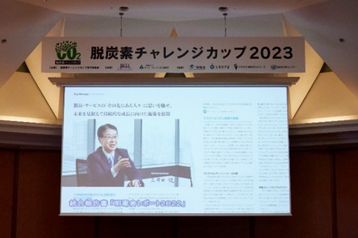
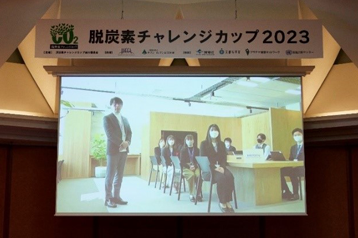
The new office building was designed and built with consideration given to environmental factors. As a result, it received the “ZEB Ready”*1 rating as defined by the Ministry of Economy, Trade and Industry, and a five-star rating in the Building-housing Energy-efficiency Labeling System (BELS). The office has also introduced ABW*2 as part of efforts to achieve workstyle reform. Additionally, the building introduced a self-consumption type solar power generator on the roof and a multifunctional power conditioning system (PCS)*3 to improve the Group companies’ business continuity plan.
Meidensha is also helping achieve carbon neutrality by using non-fossil certificates with tracking information in sourcing power generated at a wind farm owned by Group company M WINDS CO., LTD.
The Meiden Group makes capital investment systematically, such as introducing internal carbon pricing and replacing lighting and air-conditioning with high-efficiency equipment, to lower greenhouse gas emissions caused by energy consumption. We are in addition visualizing our power consumption and improving equipment operations, especially by practicing strict energy consumption control, such as cutting standby energy consumption on holidays and at night. To use energy more efficiently, expand energy conservation awareness, and reduce energy costs, each works and unit is endeavoring to save energy. Energy conservation rankings, showing energy use reductions, are posted on digital signage to foster awareness of energy conservation.
The Meiden Group’s emissions of greenhouse gasses other than CO2 include SF6 gas, which is used for lightning arresters and circuit breakers, etc., and CFCs, which are used as refrigerants in air conditioners.
In FY2023, emissions from leaks of SF₆ gas increased due to rising production of equipment such as circuit breakers. We will continue our efforts to curb emissions and perform technical studies and verification of alternatives to SF6 gas. To curb CFC emissions, moreover, we are strengthening management of air-conditioning equipment and updating facilities.
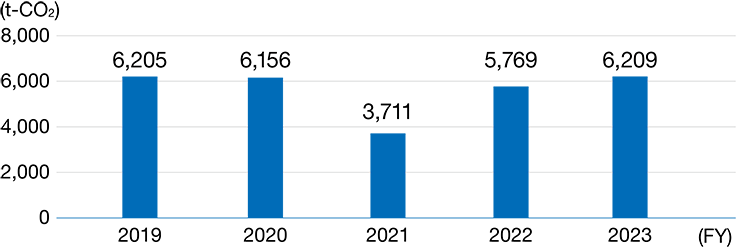
The transport division is working to reduce CO2 emissions by practicing cargo consolidation, modal shift, and efficient transport, such as using JR containers and switching from trailer transport to ship transport from nearby ports.

Meidensha is working to calculate greenhouse gas emissions, including indirect emissions in the upstream and downstream supply chain in addition to those produced in the course of its business activities.
Meidensha is facing the issue of producing a large proportion of its emissions from “use of sold products” (scope 3, category 11) and “purchased goods and services” (scope 3, category 1). We are promoting environmental measures throughout the entire supply chain, including reducing downstream greenhouse emissions through environmentally considerate product design and reducing upstream impact through green procurement.
We calculate for our supply chain with reference to the Basic Guidelines on Accounting for Greenhouse Gas Emissions Throughout the Supply Chain, published by the Ministry of the Environment and the Ministry of Economy, Trade and Industry, etc.
In developing the Second Meiden Environmental Vision, which set new medium-to-long-term environmental targets and launched in FY2021, we completely reviewed Scope 3 calculation methods. We transitioned from calculating the non-consolidated value of Meidensha to calculating the consolidated value of the Meiden Group, and conducted review of units for our FY2021 record. For Category 11, we increased precision by conducting more detailed calculation of emissions per unit of production for each product group. For categories calculated on a monetary basis, we also reviewed part of our standards going back to FY2019. Thus, data values disclosed up to FY2021 lack continuity; however, going forward we intend to trace these values using this calculation method and revise them as necessary.